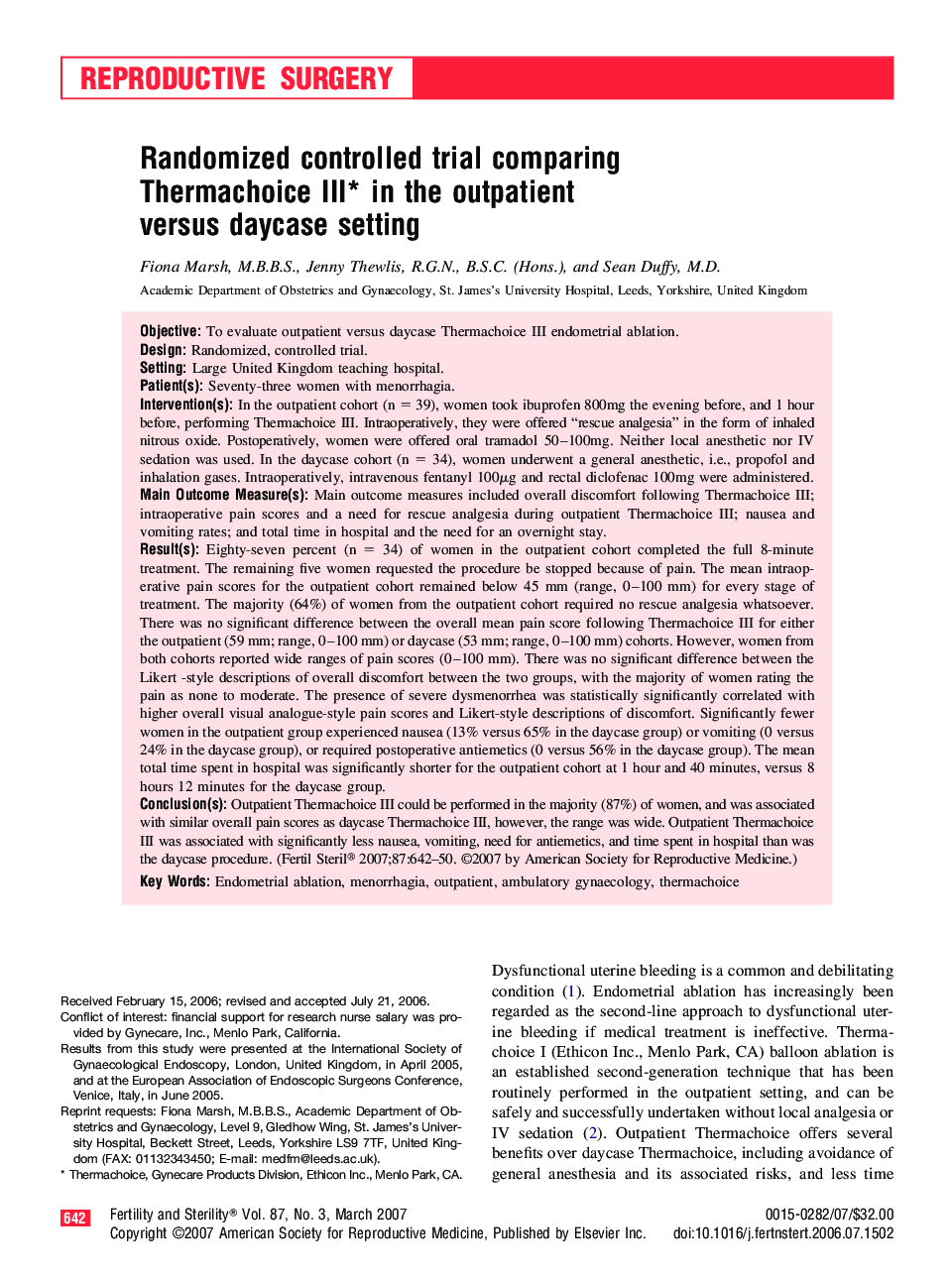| کد مقاله | کد نشریه | سال انتشار | مقاله انگلیسی | نسخه تمام متن |
|---|---|---|---|---|
| 3940156 | 1253580 | 2007 | 9 صفحه PDF | دانلود رایگان |

ObjectiveTo evaluate outpatient versus daycase Thermachoice III endometrial ablation.DesignRandomized, controlled trial.SettingLarge United Kingdom teaching hospital.Patient(s)Seventy-three women with menorrhagia.Intervention(s)In the outpatient cohort (n = 39), women took ibuprofen 800mg the evening before, and 1 hour before, performing Thermachoice III. Intraoperatively, they were offered “rescue analgesia” in the form of inhaled nitrous oxide. Postoperatively, women were offered oral tramadol 50–100mg. Neither local anesthetic nor IV sedation was used. In the daycase cohort (n = 34), women underwent a general anesthetic, i.e., propofol and inhalation gases. Intraoperatively, intravenous fentanyl 100μg and rectal diclofenac 100mg were administered.Main Outcome Measure(s)Main outcome measures included overall discomfort following Thermachoice III; intraoperative pain scores and a need for rescue analgesia during outpatient Thermachoice III; nausea and vomiting rates; and total time in hospital and the need for an overnight stay.Result(s)Eighty-seven percent (n = 34) of women in the outpatient cohort completed the full 8-minute treatment. The remaining five women requested the procedure be stopped because of pain. The mean intraoperative pain scores for the outpatient cohort remained below 45 mm (range, 0–100 mm) for every stage of treatment. The majority (64%) of women from the outpatient cohort required no rescue analgesia whatsoever. There was no significant difference between the overall mean pain score following Thermachoice III for either the outpatient (59 mm; range, 0–100 mm) or daycase (53 mm; range, 0–100 mm) cohorts. However, women from both cohorts reported wide ranges of pain scores (0–100 mm). There was no significant difference between the Likert -style descriptions of overall discomfort between the two groups, with the majority of women rating the pain as none to moderate. The presence of severe dysmenorrhea was statistically significantly correlated with higher overall visual analogue-style pain scores and Likert-style descriptions of discomfort. Significantly fewer women in the outpatient group experienced nausea (13% versus 65% in the daycase group) or vomiting (0 versus 24% in the daycase group), or required postoperative antiemetics (0 versus 56% in the daycase group). The mean total time spent in hospital was significantly shorter for the outpatient cohort at 1 hour and 40 minutes, versus 8 hours 12 minutes for the daycase group.Conclusion(s)Outpatient Thermachoice III could be performed in the majority (87%) of women, and was associated with similar overall pain scores as daycase Thermachoice III, however, the range was wide. Outpatient Thermachoice III was associated with significantly less nausea, vomiting, need for antiemetics, and time spent in hospital than was the daycase procedure.
Journal: Fertility and Sterility - Volume 87, Issue 3, March 2007, Pages 642–650